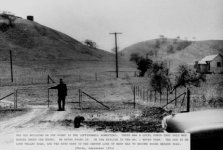Gypsy Heart
Gold Member
Leffingwell Homestead on Long Valley Road and what will become Round Meadow Road, Calabasas, 1951
Description Leffingwell Homestead and property located on Long Valley Road and what will become Round Meadow Road, Calabasas, September 1951. Caption attached to photograph reads: "The old building on the right is the Leffingwell Homestead. There was a local rumor that gold was buried under the house. We never found it. On the skyline is the No. 1 water tank. The car is on Long Valley Road, and the wire gate is the center line of what was to become Round Meadow Road
Description Leffingwell Homestead and property located on Long Valley Road and what will become Round Meadow Road, Calabasas, September 1951. Caption attached to photograph reads: "The old building on the right is the Leffingwell Homestead. There was a local rumor that gold was buried under the house. We never found it. On the skyline is the No. 1 water tank. The car is on Long Valley Road, and the wire gate is the center line of what was to become Round Meadow Road









